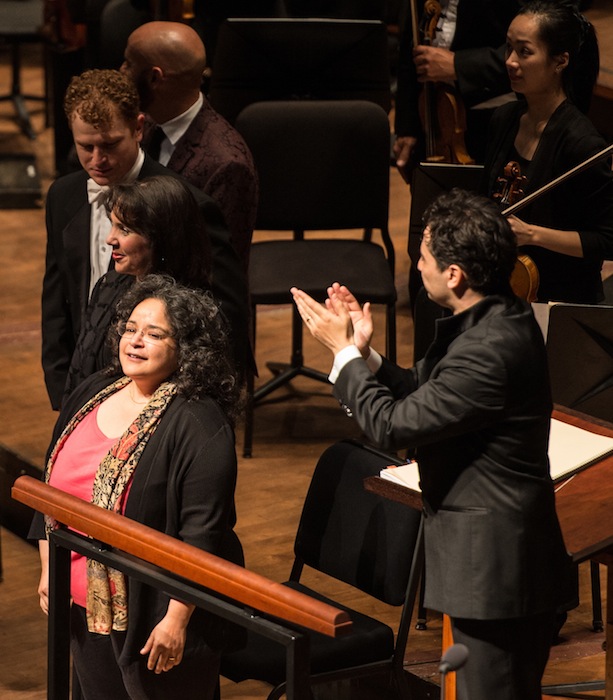Frank’s “Conquest Requiem” receives stirring premiere from Houston Symphony

Andrés Orozco-Estrada applauds composer Gabriela Lena Frank (with soprano Jessica Rivera) following the world premiere of Frank’s”Conquest Requiem” with the Houston Symphony Friday night at Jones Hall. Photo: Wilson Parish
The concert by the Houston Symphony at Jones Hall Friday night featured many colors. First on the program was the world premiére of Gabriela Lena Frank’s Conquest Requiem, a seven-movement work for soprano, baritone, chorus and orchestra commissioned by the Houston Symphony. Music Director Andrés Orozco-Estrada conducted, following the Frank premiere with Shostakovich’s Symphony No. 5 on the second half.
This Conquest Requiem debut marks the high point of Frank’s tenure as the Houston Symphony’s composer-in-residence. Frank’s work often draws on her multicultural background, especially her Peruvian heritage. This work interweaves traditional Latin and Meso-American texts with contemporary settings by Pulitzer Prize-winning Cuban-American writer Nilo Cruz.
Frank wrote: “While a requiem in the traditional sense in that it speaks generally of life and loss, this requiem is positioned from the vantage point of the Spanish Conquest of the New World in present-day Mexico. Specifically, we hear the voices of Malinche, the multi-lingual concubine of conquistador Hernán Cortés, and their son Martín, one of the first ‘mestizos’ of the New World, as they describe the destruction and rebirth of their land.”
Conquest Requiem is written for a large orchestra, including prominent bass drum and harp parts. Frank’s orchestration offers a vast variety of instrumental combinations and textures. The music shows a brilliant musical mind seeking an ideal combination of sounds to express emotions or to illuminate the text. The variety of the scoring is both fascinating and captivating and Orozco-Estrada led the Houston Symphony and chorus in an energetic and well-executed performance.
The vocal highlights of the evening came from soloist Jessica Rivera, who brought Malinche to life. A radiant presence on stage, Rivera’s soprano projected effortlessly and with tonal variety–from a sensitively sung “Song of Malinche” to a howl in the Rex Tremendae. Rivera’s committed and imaginative performance was a large part of the success of this new work.
Making his Houston Symphony debut was baritone Andrew Garland. Following a tentative first entrance, his voice never quite found its center.
The Houston Symphony Chorus has a substantial role, singing in Latin with added humming and half-sung exclamations. There were occasional balance issues, particularly during long vocal lines. But for the most part the singers exhibited their customary excellent preparation, greatly contributing to the operatic qualities of the work.
One of the most popular and hotly debated works of the 20th century, there is little consensus as to the composer’s actual intent in Shostakovich’s Fifth Symphony. But given the dangers he faced in Stalin’s Soviet Union one can find much that is hidden in plain sight. The symphony is an emotional powerhouse filled with vivid orchestral colors.
The symphony began with incisive and cohesive playing from the Houston Symphony string section. Contrasting this were high delicate melodies in the first violins and violas. For their part, the violas played this notoriously difficult melody flawlessly. There were outstanding wind solos and the brass section provided power, especially at the movement’s frenetic climax.
In the heavy-footed second movement, Orozco-Estrada brought out the music’s gruff and sardonic character. This was contrasted with a delicate and flexible trio section, featuring well-played flute and violin solos.
The third movement is one of the most intensely emotional in all music. The second violins often take the lead, and the section was wonderfully expressive and together. Flutist Aralee Dorough played beautifully, and when joined by flutist Judy Dines, the combination was gorgeous.
The fourth movement was characterized by brilliant string playing, expressive winds and richly powerful brass and percussion. Orozco-Estrada took the loud final section at a steady pace allowing for the expression of mock triumph.
The program will be repeated 8 p.m. Saturday, and 2:30 p.m. Sunday. houstonsymphony.org